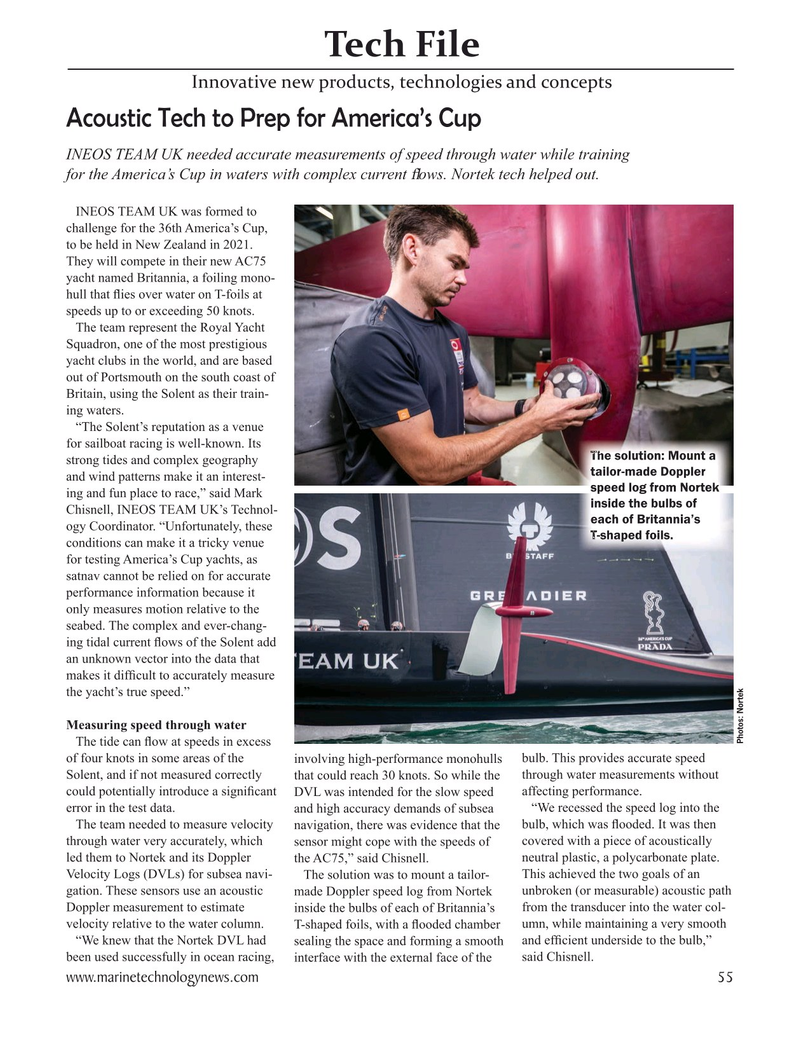
Page 55: of Marine Technology Magazine (January 2021)
Underwater Vehicle Annual
Read this page in Pdf, Flash or Html5 edition of January 2021 Marine Technology Magazine
Tech File
Innovative new products, technologies and concepts
Acoustic Tech to Prep for America’s Cup
INEOS TEAM UK needed accurate measurements of speed through water while training for the America’s Cup in waters with complex current ? ows. Nortek tech helped out.
INEOS TEAM UK was formed to challenge for the 36th America’s Cup, to be held in New Zealand in 2021.
They will compete in their new AC75 yacht named Britannia, a foiling mono- hull that ? ies over water on T-foils at speeds up to or exceeding 50 knots.
The team represent the Royal Yacht
Squadron, one of the most prestigious yacht clubs in the world, and are based out of Portsmouth on the south coast of
Britain, using the Solent as their train- ing waters. “The Solent’s reputation as a venue for sailboat racing is well-known. Its
ThThT T T T T T ThTh T e solu luti tion: Mo Mount t a a strong tides and complex geography t tailor-made Doppler and wind patterns make it an interest- p g s s speed log from Nortek k kspeedlogfromNortek ing and fun place to race,” said Mark i inside the bulbs of
Chisnell, INEOS TEAM UK’s Technol- e each of Britannia’s ogy Coordinator. “Unfortunately, these s aped f sh T T T T T- T- T- T- T- T shap p p ped foi oils ls.
conditions can make it a tricky venue for testing America’s Cup yachts, as satnav cannot be relied on for accurate performance information because it only measures motion relative to the seabed. The complex and ever-chang- ing tidal current ? ows of the Solent add an unknown vector into the data that makes it dif? cult to accurately measure the yacht’s true speed.”
Measuring speed through water
Photos: Nortek
The tide can ? ow at speeds in excess of four knots in some areas of the involving high-performance monohulls bulb. This provides accurate speed
Solent, and if not measured correctly that could reach 30 knots. So while the through water measurements without could potentially introduce a signi? cant DVL was intended for the slow speed affecting performance. error in the test data. and high accuracy demands of subsea “We recessed the speed log into the
The team needed to measure velocity navigation, there was evidence that the bulb, which was ? ooded. It was then through water very accurately, which sensor might cope with the speeds of covered with a piece of acoustically led them to Nortek and its Doppler the AC75,” said Chisnell. neutral plastic, a polycarbonate plate.
Velocity Logs (DVLs) for subsea navi- The solution was to mount a tailor- This achieved the two goals of an gation. These sensors use an acoustic made Doppler speed log from Nortek unbroken (or measurable) acoustic path
Doppler measurement to estimate inside the bulbs of each of Britannia’s from the transducer into the water col- velocity relative to the water column. T-shaped foils, with a ? ooded chamber umn, while maintaining a very smooth “We knew that the Nortek DVL had sealing the space and forming a smooth and ef? cient underside to the bulb,” been used successfully in ocean racing, interface with the external face of the said Chisnell.
www.marinetechnologynews.com 55
MTR #1 (50-63).indd 55 1/25/2021 8:29:47 AM

 54
54

 56
56
